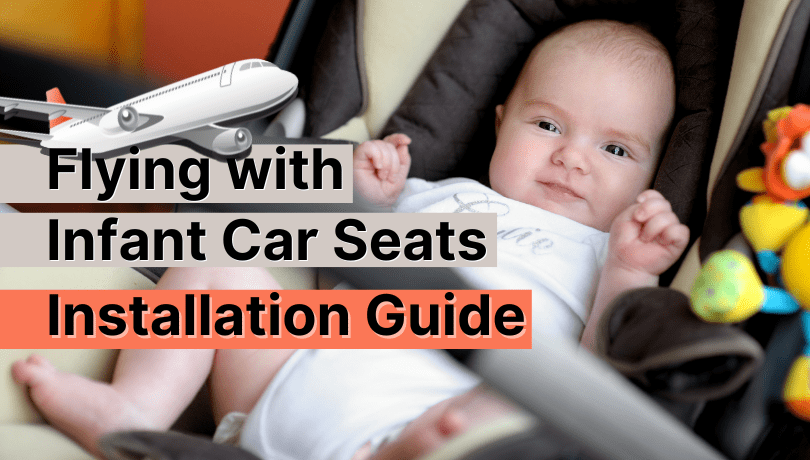Flying with Infant Car Seats: A Practical Installation Guide
Traveling with your little one doesn’t need to be stressful!
And just because you’re a parent now doesn’t mean you have to give up on your travel dreams. With a bit of guidance and planning, you can make it work. So, let’s look at flying with infant car seats, how to install infant car seats on airplanes, and alternatives you can consider.
Your first trip with your new baby is a special memory. Let’s make it a pleasant one!
Table of Contents

Infant Car Seats for Air Travel
The safest way to travel with your infant is in an FAA-approved CRS (child restraint system). CRS, or infant car seats, are rear-facing and hard-backed. They strap into airplane seats using seat belts.
- Kids weighing less than 20 lbs should be in rear-facing CRS, and children between 20 and 40 lbs should be in forward-facing CRS.
- Ensure your CRS is approved for aircraft use, or you might have to gate-check it. Look for a label on the carrier or check the manufacturer’s manual to confirm.
Dear parents,
- Flying with your little one in your lap isn’t safe.
- Wearing your baby in a soft wrap is also not recommended because your arms can’t secure your child properly during turbulence or mealtime.
Please use infant car seats or other safe alternatives when flying with your baby.
How to Install Infant Car Seats on Airplanes?
We can’t afford to mess around with the car seat installation while flying. And improper installation totally defeats the purpose! So, take your time to understand how to install the car seat properly, first on the plane, then in any other vehicle.
1. Installing The Car Seat On A Plane
Please ensure you install the car seat exactly according to the manufacturer’s instructions. This includes using age-appropriate rear-facing or forward-facing seats for your little one.
- Raise the armrest, and place the rear-facing or forward-facing seat on the plane seat.
- For a rear-facing seat, check if the incline is appropriate for your little one, just as you would in your car.
- Thread the plane’s seat belt through the belt pathways and bring it over the rear-facing car seat.
- For the forward-facing seat, thread the belt through the belt pad, situated behind the seat pad.
- Tighten the belt as much as possible and test the seat. If it moves back and forth or sideways, more than an inch, do it again.
Recommended Reading: Infant Car Seat vs Convertible
2. Installing After Reaching The Destination
Most parents don’t think about preparing for this stage. What could be so hard about installing the car seat onto a new vehicle? The short answer? Many things.
So, to avoid being rushed by impatient drivers at the airport, practice installing the seat without the base a couple of times. However, you must be prepared for a few things:
- Since US seats aren’t allowed everywhere, learn how to install a legal car seat that’s allowed at your destination.
- It is even more necessary if you plan to rent a car seat because rental companies don’t install the car seat to avoid any liability issues.
You May Also Like: Where to Place Infant Car Seats – Behind Driver or Passenger?
Also, in Europe, car seat belts don’t ‘lock in’ or ‘click in’. They’re loose to wrap around the seat. You can use car seat clips to hold them in place.
Flying with Infant Car Seats: Important Concerns
1. What If Your Baby Does Not Like Their Infant Car Seat?
The car seat is an excellent option to give you some hands-free time on the flight. But what if your little one doesn’t like their CRS?
- You’ll eventually have to take them out and carry them. So, plan for alternatives in such scenarios and ask yourself if you’re comfortable carrying them throughout the flight if that happens.
- My second child, Aiden, hated being in the car seat on flights. So, we carried a bassinet for longer or international flights.

2. Is Your Car Seat Legal At Your Destination?
- Most US-approved infant car seats or child restraint systems aren’t legal in Europe. You can only use EU-approved height-based car seats if you plan to travel to any European country.
- Hence, I always recommend researching the car seat or road safety regulations at your destination before packing your car seat.

3. What Are Your Transportation Options Once You Get There?
- Know your transportation options before you reach your destination. Fix a transport to take you from the airport to the hotel.
- If you are using public transport, please check the timings. You can also check if you can pre-book a car with a car seat installed.
4. Can You Rent A Car Seat At The Destination?
- If your car seat is not legal at your destination, check if you can rent a car seat there as a workaround.
- However, some might find rented seats a bit tricky. Please inspect it thoroughly because damage isn’t always visible. In any case, it’s better than not using one at all!
Recommended Reading: How to store an infant car seat to keep it safe and intact
FAQs on Flying with Infant Car Seats

1. At What Age Is It Safe to Travel With Your Baby?
Doctors, pediatricians, and experts all agree that traveling with a newborn younger than 7 days is risky.
Crowded mass transportation can be dangerous for newborns. They can even catch infectious diseases as their immune system doesn’t mature before 2 to 3 months.
So, it’s safer to wait until they’re at least 2 to 3 months old before traveling. Personally, I decided to wait until Avery was 6 months old to take our first trip with her.
2. Which Airplane Seats Are Best?
The safest seat for your infant is the window seat. The aisle seats are a strict no because
1. Hot beverages or food can spill on your baby during meal service if you’re in an aisle seat.
2. Aisle seats are also closest to the overhead bins. If anything falls, it can seriously injure your little one.
3. The moving carts can even bump into their CRS, or their hands and legs can get caught by the carts if they try to reach and grab it.
Visit the Airline Family Seating Dashboard to ensure you and your little one are seated together during the flight – it requires no extra cost!
3. How To Bring Car Seats For Air Travel?
Check your airline policies before booking your tickets – some don’t consider strollers, car seats, or booster seats as luggage. Get a car seat cart or travel belt to make it easier to lug it around the airport.
1. Car Seat Travel Belt – Links your car seat with your luggage or the travel system. It also makes it easier to install the seat once you board.
2. Car Seat Cart – Carts are best if the car seat is heavy, and you don’t have a travel system. They’re foldable so you can put them in the overhead bin.
I recommend gate-checking your car seat. We’ve all seen videos of luggage being tossed around, and damage to car seats isn’t always visible. But if you must, here are a few tips:
1. Wrap it with as much padding as possible in its original box. It survived the first trip to your home, so, it can survive another.
2. Take photos from all angles before checking the car seat to ensure you have proof in case it does arrive damaged.
Flying With Infant Car Seats: Tips and Tricks
- Buy Them a Seat – If you’re in for a long haul, buy your little one a separate seat, even under 2 years old. The FAA and AAP always recommend strapping your baby in while flying to avoid severe injuries in case of a crash or runway collision.
- Research, Research, and Research – Research is key. Understand the road safety regulations at your destination and the rules of the airline you’re flying with. In the US, airlines must let you fly with a car seat, but it varies in other countries. So, always check ahead.
- Precautions for Checking – If you must check your CRS at the gate, take precautions to protect it from damage. Wrap it well, add extra padding, and take a photo before checking in.
- Installation – Knowing the proper installation technique is critical. But don’t worry! Installing the car seat on the flight is often easier than in a car. Since most car seat bases aren’t FAA-approved, you may have to install it without one.
- In-Flight Sanity – Limit the items you bring onboard and shower your little one with attention. Instead of carrying ten different toys, play with them, read to them, and engage.
Benefits of Flying With Infant Car Seats

- Your infant will be snug in their own seat, free to snooze or play without feeling cramped.
- Buckle up for peace of mind knowing your baby is secured in their familiar car seat, meeting safety standards even at 30,000 feet.
- It encourages longer stretches of sleep by replicating a cozy car environment in flight.
- For longer flights, you can enjoy the freedom to move around the cabin without holding your baby throughout the flight.
- Remember it’s a vacation for you too. Infant car seats minimize stress by eliminating the need to hold your infant constantly.
- It creates a barrier between your baby and potentially germ-filled airplane seats, rental car seats, and more.
- The car seat’s canopy can shield your baby from bright lights and create a cozy cocoon for nap time.
- Lastly, by flying with the infant car seat, you can ensure no one manhandles it. Thus, it’s not damaged.
Alternative Infant Car Seats for Travel
1. Child Aviation Restraint System (CARES)
- It’s a restraint system (FAA-approved) used only on flights for children weighing 22 to 44 lbs.
- It is also great for a growing toddler who isn’t big enough for the airplane seat belt just yet. You can also use the CARES in any row.
2. In-Flight Bassinet or Sky-Cot
- Some international airlines offer sky-cots or in-flight bassinets for babies under 6 months. But, know that they can’t be used during take-off, landing, or turbulence.
- Request a sky-cot when reserving your tickets, as they can only be used in certain seats. Usually, if you opt for a bulkhead seat, you can opt to get the sky-cot or bassinet.
Final Words: Flying With Infant Car Seats
It’s an incredible feeling to experience the world with your baby. You only need to research, prepare, and plan for a convenient and comfortable journey.
I suggest traveling with the infant car seat – it ensures safety for your baby and comfort for the parents. Simply adhere to the necessary regulations and follow the installation guidelines thoroughly to ensure a safe and memorable journey with your little one.
Happy traveling folks!




![When to Flip a Baby Mattress? [A Complete Guide]](https://www.imperfecthomemaking.com/wp-content/uploads/2024/02/when-to-flip-a-baby-mattress-768x432.png)

